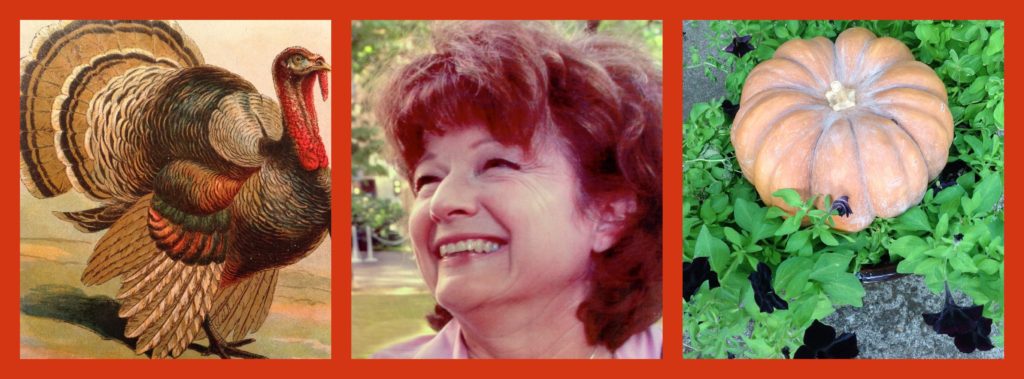Most of us know by now that it’s quite difficult to find poultry, especially turkeys, that have been fed organic feed and raised in healthy, spacious conditions. Grocery stores tend to sell only genetically modified turkeys that eat genetically modified food – food that has been modified to withstand large concentrations of pesticides. Ugh. Yet a beautifully browned bird coming out of the kitchen on a platter is a festive centerpiece that’s difficult to top.
My associate, Dianne Ruff, created a wonderful alternative. She calls it “The Great Stuffed Pumpkin.” Like most good cooks, she doesn’t use a recipe but she did manage to write this one down for us. Thank you, Dianne!
Over time, Dianne has contributed many fine ideas to help create The Joy of Plenty. She loves all things food and farming. She’s been the Executive Director of the Portland Farmers Market, founding member of the Oregon Farmers Market Association, a member of the Multnomah Food Policy Council and currently teaches for the Food Matters Program sponsored by the Oregon Food Bank.

Her recipe is an excellent example of the freedom a person can experience when they cook using The Joy of Plenty way. Mix and match the ingredients, use what you have on hand. Improvise and discover the music of food and be a symphony conductor in your own kitchen.
Here goes, in her own words:
This “recipe” makes an impressive centerpiece for a special meal and is a great choice for a vegetarian holiday option. You can find most of the ingredients in your pantry. Use your favorite stuffing recipe or follow my suggestions. If you aren’t serving vegetarians, a pound of browned sausage or some bacon make a great addition. If you want to make it vegan just omit the cheese and use coconut milk instead of cream. I’ve even made it with gluten free bread, but my favorite is with an artisan loaf of peasant bread.
Select an heirloom winter squash. The Rouge D’Etampes or Cinderella squash makes an especially beautiful presentation. I’ve also used Kabocha and Hubbard. The amounts listed here make enough to fill a 5 pounder. If you can, pick one with a stem – it will make a charming cap for your masterpiece. Be sure and save yourself some grief and ask the nice person in the produce section (or the farmer at the market) to cut the top off for you. Cut it just like you would to make a jack-o-lantern.
On the day before you want to make the stuffing, rough cube a loaf of artisan bread. Spread the cubes on cookie sheets. You should have enough to lightly cover two sheets and still have a piece or two to munch while your working. Pop the sheets into a 150-200-degree oven and let them dry out. After an hour, turn the oven off and leave the cubes to continue drying until you’re ready to use them. Just don’t forget and turn the oven on high for some other project (like I did). Your kitchen will still smell like burnt toast the next day when your guests arrive.
Time to get serious – dice a large onion, 5 or 6 stalks of celery, and a poundish of white mushrooms or if you have them on hand, you can use dried. Sauté in a little oil until the onions are translucent and the mushrooms cooked. (Along in here, if no one is looking, I toss in a half a cube of butter.) Add a generous tablespoon of fresh minced sage. Some dried poultry spice is also good.
While things are sautéing chop a cup of your favorite nuts – walnut, pecan, or hazelnut – whichever you have in the pantry – and toast in a dry skillet until they start to smell yummy. Do you have some olives on hand? A cup of sliced olives tastes great in your stuffing. Another great pantry item to add is dried cranberries, a generous half-cup will punch up the flavor. What about some chestnuts?
In a large mixing bowl add the sautéed mixture, the nuts, olives and cranberries. To make the stuffing really special, add 8 ounces of cubed Gruyere cheese. Don’t be shy with the salt, pepper and fresh parsley. Taste and adjust as needed.
Here’s where you need to make a judgment call. The mixture needs to be moistened. You don’t want it mushy, but you do want it wet enough to slightly hold together when you squeeze a handful. Start with a half a cup of stock (and a splash of white wine if you’re inclined) and work your way up.
Before filling your squash, scrape out the seeds and strings. Smear some butter or olive oil around the inside and generously salt and pepper.
At last, you’re ready to stuff your masterpiece. Really pack it in there. Top it off by drizzling ½ cup of cream over the stuffing. Replace the lid and transfer to a parchment covered cookie sheet or low baking dish. Now’s the time to think about how you’ll get the cooked squash to a serving platter. After all this, I want to display mine on a pedestal cake plate in the center of the table. Alas, sometimes the squash becomes too soft and will need to be served from a low bowl or straight from the baking dish.
Bake in the center of a 350-degree oven for ninety minutes (more or less – the time depends on the size of your squash). Poke the squash with a fork and when it offers no resistance it’s done. About half way through baking remove the lid so the stuffing can brown.
Allow the squash to cool for a few minutes before transferring to a serving dish. Replace the cap at a jaunty angle and stand back and admire your handiwork. Mushroom gravy and cranberry sauce make the perfect accompaniments. Anyway you serve your squash, it’s an impressive and delicious dish – and it’s even tastier the next day.
Try it, you’ll like it!
